Tools
Salesmate vs Close: CRM Features, Integrations, and Reviews
Discover the key differences between Salesmate and Close in this in-depth comparison. Make an informed decision for your business's CRM needs.
Jul 30, 2024

Overview of Salesmate and Close
When you're on the hunt for the right CRM tool, understanding your options is key. Let's jump into two popular choices: Salesmate and Close. Both serve as robust CRM solutions but with distinct characteristics tailored to different sales needs.
Salesmate
Salesmate caters to small to medium-sized businesses aiming to streamline sales processes. It offers an intuitive interface, which ensures you spend less time learning the software and more on actual selling. Here are some notable features of Salesmate:
Pipeline Management: Visualize and track your deals from start to finish.
Customization: Tailor the CRM to fit your business needs with customizable fields.
Automation: Automate repetitive tasks like follow-ups and reminders.
Integrations: Connect seamlessly with tools like Gmail, Google Calendar, and more.
Salesmate's strength lies in its flexibility. You can tweak it to support various sales strategies, whether you're conducting cold email outreach or managing inbound leads.
Close
Close focuses on sales productivity. It's designed for inside sales teams that thrive on making calls and sending emails. Key features of Close include:
Built-In Calling: Make and receive calls directly from the CRM without needing a separate phone system.
Email Sequencing: Set up automated email sequences to nurture leads.
Open API: Integrate with any other tools you're already using through its open API.
Reporting: Access detailed sales reporting to monitor performance metrics.
Close shines in organizations heavily reliant on direct communication like phone calls and emails. It's particularly handy for businesses engaging in high-volume outreach.
Common Mistakes and Misconceptions
It's easy to assume that any CRM will solve all your problems, but that's not the case. Many believe you only need to input data, and results will follow. But, CRMs require consistent and strategic input. Here’s a quick rundown of mistakes to avoid:
Overloading with Features: More isn't always better. Stick to what your team will actually use.
Ignoring Training: Even the most user-friendly CRM requires proper training for effective use.
Inconsistent Data Entry: Ensure your team regularly updates information to avoid a data mess.
To avoid these mistakes, prioritize user adoption and continuous training. Regularly review which features add value to your process.
Techniques and Best Practices
Different situations call for different techniques. When focusing on lead generation through cold email or LinkedIn outreach, consider these methods:
Cold Email Outreach: Tools like Growleady, an Instantly partner, simplify your campaigns. Use personalization to increase engagement rates.
LinkedIn Outreach: Leverage LinkedIn Sales Navigator to find and connect with potential leads. Tailor messages to show genuine interest in their profile.
Ensure you're consistent in your approach. Building reliable follow-up routines can significantly increase your success rates.
Practical Tips
To maximize the potential of your CRM, integrate it with your daily practices:
Centralize Data: Keep all your contacts, emails, and call notes in one place for easy access.
Automate Where Possible: Use automation features like email sequences to save time.
Monitor Metrics: Regularly check reports to understand what's working and what needs adjustment.
Salesmate and Close each have unique strengths that are suitable for different objectives. Choosing the right CRM depends on your specific needs and how you align it with your sales process.
Key Features of Salesmate
Customization
Salesmate offers extensive customization options so it can adapt to your unique sales processes. Customize fields, pipelines, and stages to match how your team works. This flexibility ensures the CRM grows with your business. For instance, you can set up custom sales pipelines for different products or services, helping you track every deal with precision.
Sales Automation
Automation in Salesmate allows you to focus more on selling and less on administrative tasks. Automate repetitive tasks like follow-up emails, reminders, and data entry. Create workflows that trigger actions based on specific events, such as sending a thank-you email when a deal closes. These automations save time and ensure consistent communication with your leads.
Built-in Calling
Salesmate's built-in calling feature turns your CRM into a comprehensive communication tool. Make calls directly from the platform, log call details automatically, and analyze call metrics. This integrated approach helps streamline your sales communication and keeps all interactions logged in one place.
Email Tracking and Templates
Email tracking helps you know when a lead opens your email or clicks a link, giving you insights into their engagement. Use pre-built templates for common emails to save time and maintain consistency. With email tracking, you can follow up at the right time, making your outreach more effective.
Deal Management
Salesmate simplifies deal management with visual pipelines. View all your deals in one place, see their progress, and identify potential bottlenecks. Use drag-and-drop functionality to update deal stages effortlessly. This visual approach helps you stay organized and focus on deals that need attention.
Reporting and Analytics
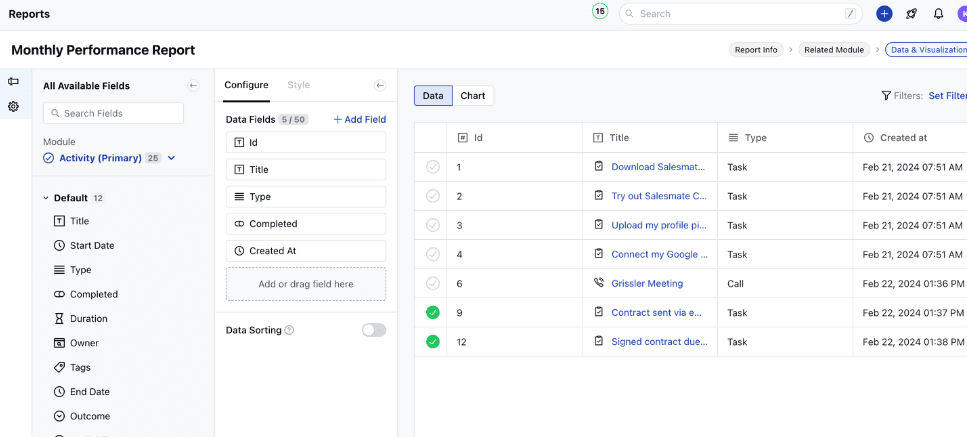
Get detailed insights into your sales performance with Salesmate's reporting and analytics features. Track key metrics like deal velocity, conversion rates, and sales forecasts. Use these reports to make data-driven decisions and improve your sales strategy. Customizable dashboards provide a snapshot of your sales health, allowing you to monitor progress at a glance.
Third-Party Integrations
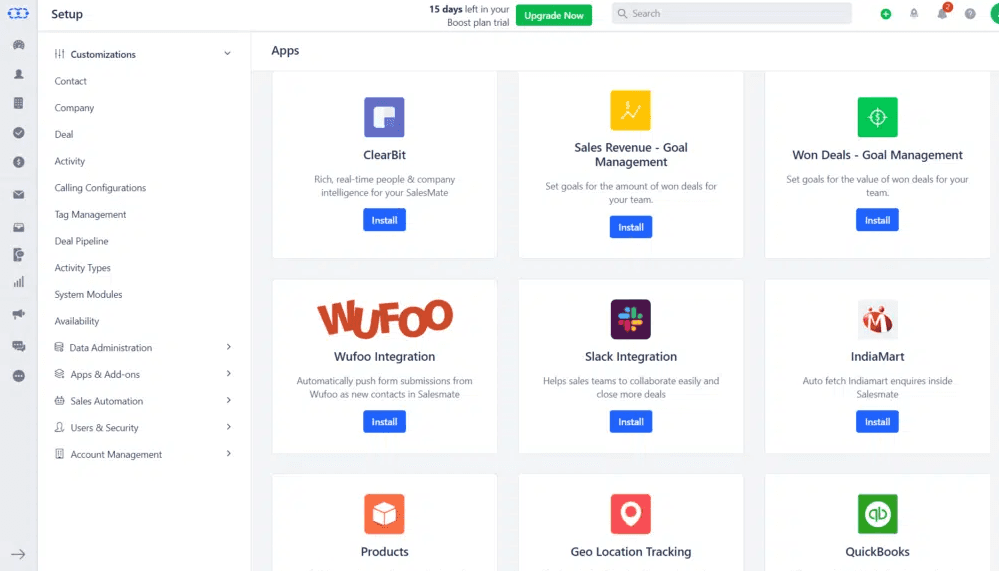
Salesmate integrates seamlessly with various third-party apps, enhancing its capabilities. Connect Salesmate with tools like Google Workspace, Microsoft Office, and social media platforms to centralize your data. Integrations with other sales and marketing tools streamline your workflow and ensure no information is lost between platforms.
Mobile App
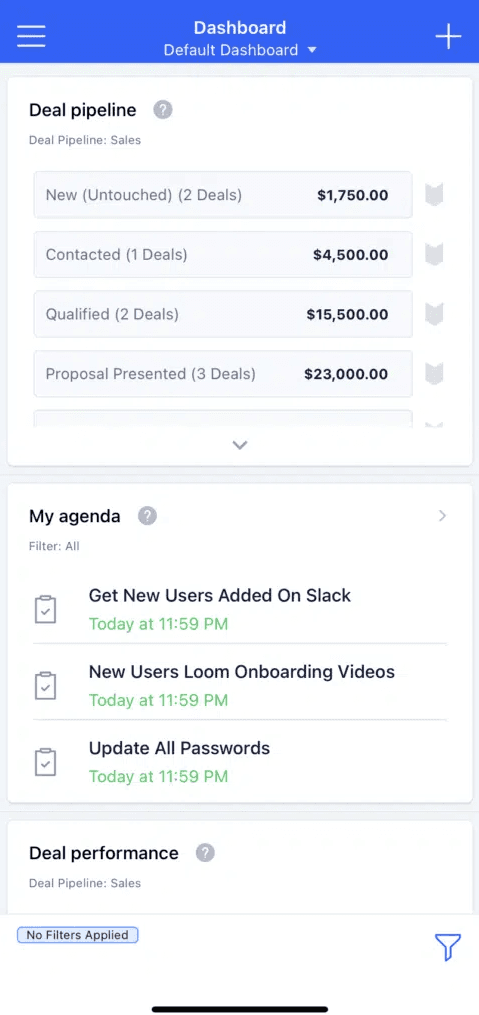
Stay connected and manage your sales activities on the go with Salesmate's mobile app. Access your CRM from anywhere, update deals, make calls, and send emails right from your smartphone. The mobile app ensures you stay productive, even when you're away from your desk.
Pipeline Management
Pipeline management in Salesmate helps you visualize your sales process from start to finish. Customize pipelines to reflect your sales stages and use visual cues to identify deal statuses. This helps prioritize tasks and ensures no deals slip through the cracks.
Customer Support
Salesmate offers robust customer support to help you get the most out of the platform. Access resources like tutorials, documentation, and a dedicated support team to resolve any issues or questions. With ongoing support, adopting and optimizing Salesmate becomes smoother for your team.
Conditional Statements
Use conditional statements within Salesmate to create dynamic fields and workflows. Set conditions under which specific actions happen, such as sending emails based on lead scores. These conditional workflows help tailor the CRM’s behavior to your business needs, enhancing its functionality.
By leveraging these key features, Salesmate can significantly improve your sales process, offering both flexibility and robust tools to manage your leads, automate tasks, and close deals more efficiently.
Key Features of Close
Close, designed with sales productivity in mind, aims to streamline every aspect of the sales process. It's an ideal match for businesses seeking to maximize outreach through channels like cold emails or LinkedIn. Let's jump into Close's standout features that make it a formidable CRM tool.
Built-in Calling
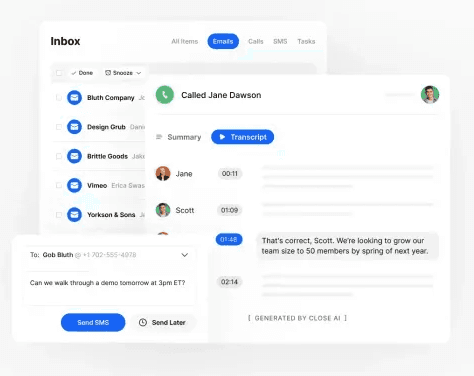
Close comes with built-in calling capabilities, which means you can make and receive calls directly within the CRM. This feature eliminates the need for third-party calling software and keeps all communication in one place. You can use it to set up call sequences, similar to how you schedule emails, ensuring you never miss a follow-up call.
Email Sequencing and Tracking
Close excels with its email sequencing and tracking. Create automated email sequences that send follow-up emails based on recipient responses or lack thereof. The tool tracks open rates, clicks, and replies, giving you insights into what's working and what's not. This is particularly useful for cold emailing campaigns, where understanding engagement metrics is crucial.
Pipeline Management
Close offers robust pipeline management features. Visualize deals through various stages from lead to deal closure. Easily drag and drop deals into different stages. This helps in keeping track of where each lead stands and what actions are required to move them forward.
Integration Capabilities
Integrations are a major strength of Close. It syncs seamlessly with numerous third-party apps, allowing you to connect your favorite tools for a more unified workflow. Popular integrations include Zapier, Slack, and Google Apps. This connectivity ensures that data flows smoothly between platforms, keeping your CRM updated in real time.
Reporting and Analytics
Data-driven decisions are key to growth, and Close supports this with comprehensive reporting and analytics. Generate custom reports to monitor metrics like sales velocity, conversion rates, and overall performance. Set up dashboards to visualize key metrics at a glance, helping you make informed decisions quickly.
Lead Management
Efficient lead management is at the core of Close. It allows you to categorize leads, set follow-up reminders, and track interactions all in one place. This ensures no lead slips through the cracks and that every potential deal is given the attention it deserves.
Multichannel Communication
Close supports multichannel communication by integrating emails, calls, and SMS into a single platform. This feature is invaluable for sales teams who want to engage leads through various touchpoints without juggling multiple tools.
Workflow Automation
Automating repetitive tasks saves time and minimizes errors. Close supports workflow automation, enabling you to set up rules that trigger actions based on specific conditions. For example, you can automatically move a lead to a new stage once they’ve opened an email or schedule a follow-up call if a lead hasn’t responded to previous emails.
Conditional Logic
Close features conditional logic in its workflows, allowing you to create more personalized and effective outreach. For instance, if a lead clicks on a particular link in an email, Close can trigger a follow-up sequence tailored to the interest shown by that action.
Mobile Accessibility
Sales teams on the go will appreciate Close's mobile app. Access all CRM functionalities from your smartphone, ensuring you stay connected and updated, even when you’re away from your desk. Real-time alerts and updates keep you informed about critical developments.
Customer Support
Close offers exceptional customer support, ensuring users get the assistance they need quickly. Whether it’s through comprehensive documentation, live chat, or email, Close is committed to helping users maximize their CRM experience.
By incorporating these key features into your sales process, Close helps you streamline operations, improve lead management, and enhance overall sales productivity.
Pricing Comparison
When comparing pricing structures, it's important to look beyond just the numbers and consider the value you get for your money. Let's break down the costs and benefits of Salesmate and Close.
Salesmate Pricing
Salesmate offers three pricing tiers designed to cater to different business needs. Here's a quick overview:
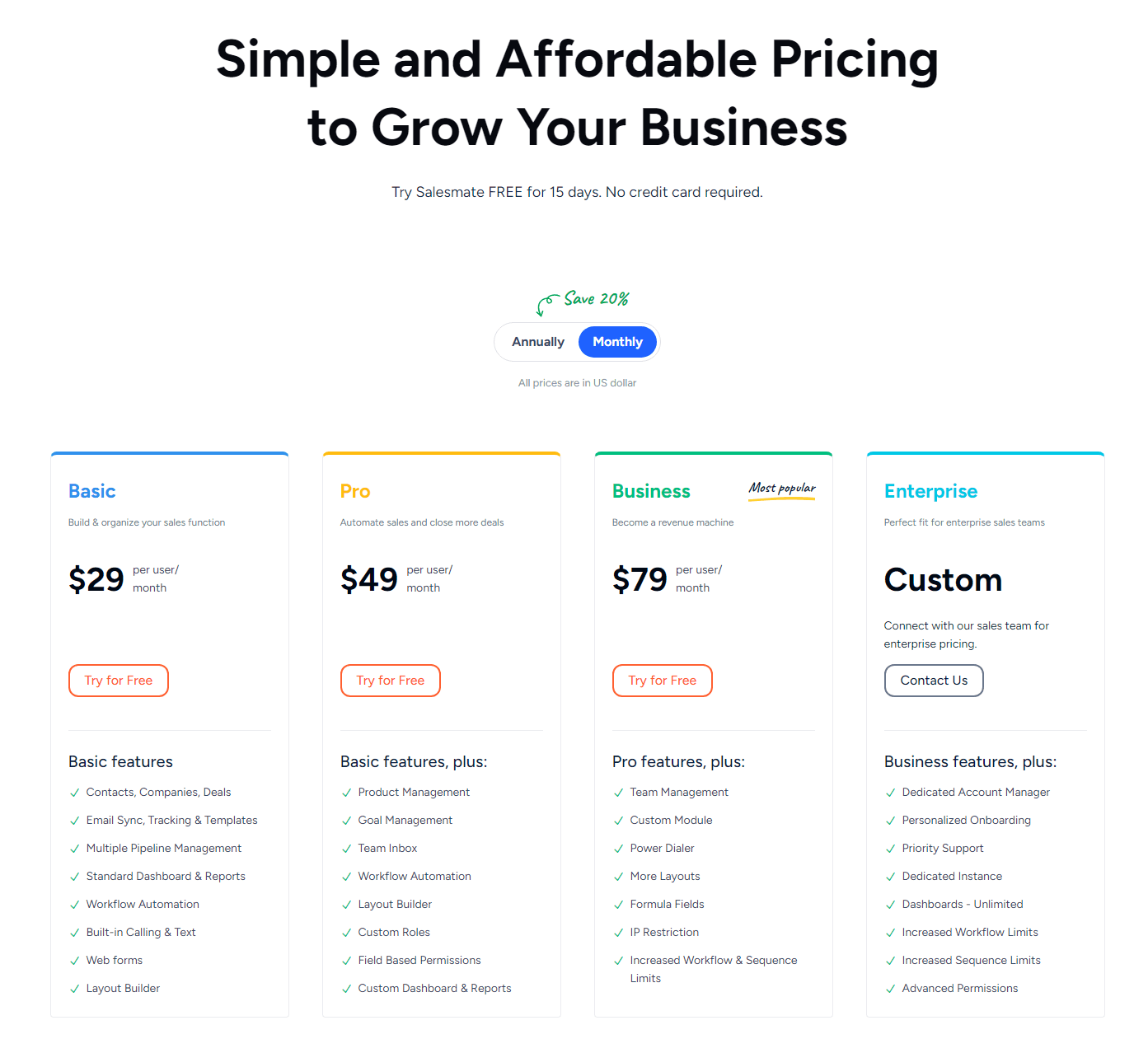
You notice the basic plan covers essential features, making it ideal if you're just starting and need fundamental CRM capabilities. The pro plan introduces more sophisticated tools, fitting if you're scaling your operations. The business plan offers advanced functionalities for businesses aiming to supercharge their sales processes with AI and detailed insights.
Close Pricing
Close structures its pricing in three tiers to accommodate diverse business requirements:
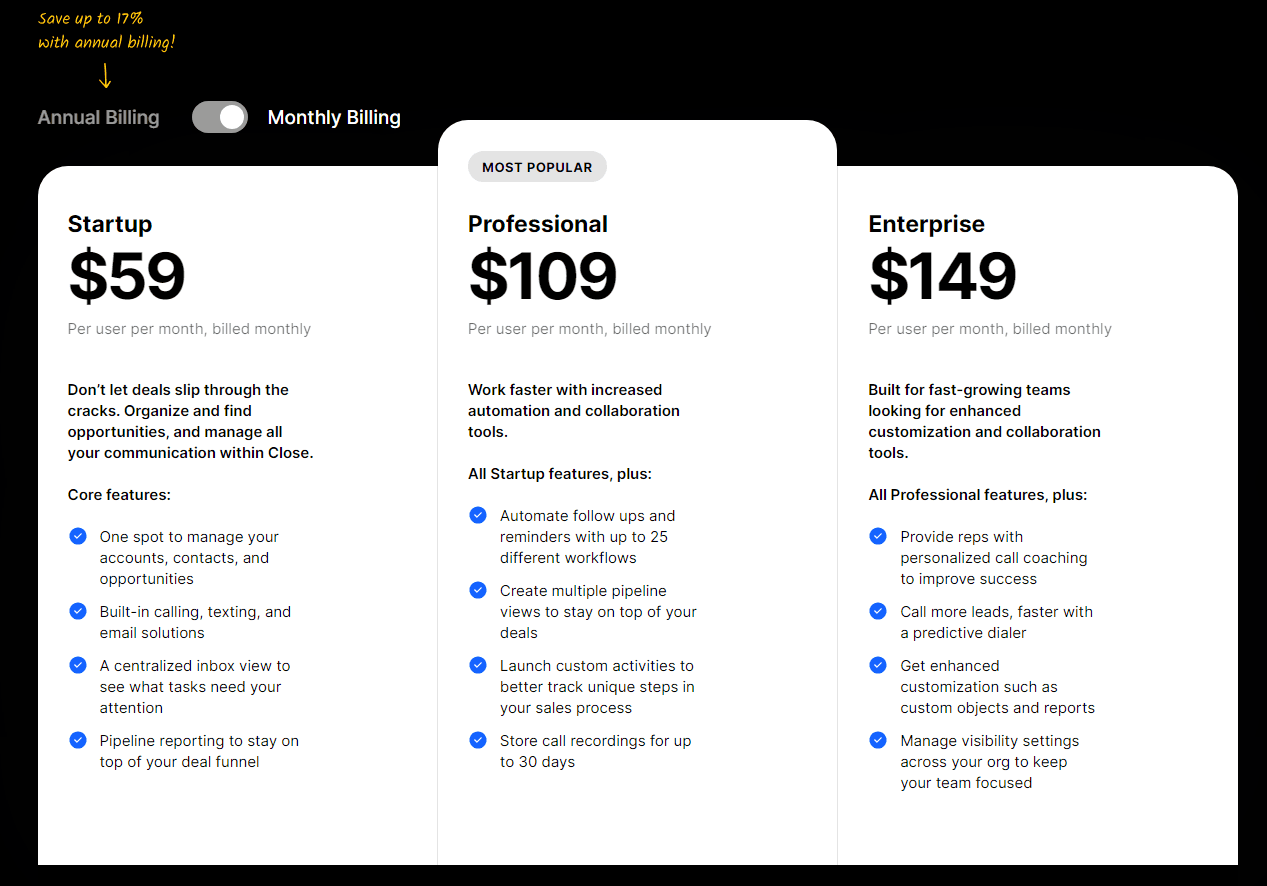
The starter plan gives essential features for basic sales tasks, making it suitable for small teams. The basic plan enhances capabilities with additional reporting tools. The professional plan introduces more advanced automation, beneficial if your team handles high call volumes. The Enterprise plan offers full customization and dedicated support, which is ideal for larger enterprises needing tailored solutions.
Key Considerations
Scalability
Consider how these plans scale with your business. Salesmate's progression from starter to boost primarily focuses on enhancing automation and AI capabilities. Close, however, significantly ramps up its calling and reporting functionalities as you move through its tiers, which is excellent if phone sales are your primary channel.
Total Cost of Ownership
Factor in the total cost of ownership by including potential add-ons or integrations you might need. Salesmate might require third-party tools for full automation, whereas Close includes extensive built-in features, potentially reducing additional software costs.
Support and Training
Both platforms offer customer support, but the level varies by plan. Salesmate's higher-tier plans include advanced support and training features, while Close's top-tier plans provide dedicated account managers. Assess your need for ongoing support to choose the right plan.
Practical Tips
Assess Feature Needs: Determine which features are critical and match them against each pricing plan. List your must-haves and would-be-nice-to-haves to make a well-informed choice.
Estimate Growth: Choose a plan that aligns with your projected growth over the next 12-24 months to avoid frequent upgrades.
Trial Runs: Both Salesmate and Close offer free trials. Use these trials to evaluate functionalities in real-world scenarios.
Budget Flexibility: Ensure your selected plan fits comfortably within your budget to avoid straining resources as you scale.
Conclusion
When weighing Salesmate and Close's pricing, consider your business's specific needs and growth trajectory. Each CRM offers unique features across different pricing tiers that can be leveraged to optimize sales processes and drive growth. Use practical tips to navigate your choices effectively, ensuring you select the best-fitting CRM for your organization.
Ease of Use and Customer Support
When evaluating CRM tools like Salesmate and Close, ease of use and customer support become vital. Nobody wants to navigate a complex maze just to send a few emails or make a couple of calls. Let’s break down how these two CRMs fare in these areas.
Ease of Use
Salesmate: Salesmate offers a user-friendly interface, making it intuitive. Customizing your pipeline or integrating with other tools is a breeze. Salesmate’s dashboard provides a clear snapshot of all your activities, helping you keep track without feeling overwhelmed. It's designed for small to medium-sized businesses, so you won’t face unnecessary complications.
Close: Close aims to simplify sales activities. The platform's built-in calling and email sequencing features save time, reducing the need to switch between different tools. The interface is straightforward, so you can focus on your tasks rather than figuring out how to use the software.
Tips for Maximum Usability:
Simplify Your Layout: Avoid cluttering dashboards. Stick to essential widgets.
Use Onboarding Resources: Use tutorials and user guides during setup.
Regularly Update Integrations: Ensure all your connected tools are compatible.
Customer Support
Salesmate: Salesmate provides robust support through live chat, email, and phone. They also offer a helpful knowledge base for self-service. Whether it’s a quick clarification or in-depth guidance, Salesmate ensures you won’t feel stranded.
Close: Close offers support via live chat, email, and an extensive knowledge base. Their customer support team is known for quick responses. While the live chat might not be 24/7, they ensure timely help during business hours.
Common Misconceptions:
Customer Support Availability: Assumptions about 24/7 support can lead to frustration. Check the support hours before making a decision.
Knowledge Base Sufficiency: Over-reliance on self-service options without utilizing direct support can lead to missteps.
Practical Tips for Effective Use
Combine CRM with Cold Email Tools: Using tools like Instantly can further simplify your processes, especially for cold emailing. Instantly integrates well with both CRM platforms, enhancing your outreach.
Leverage User Community: Both Salesmate and Close have thriving user communities. Participate in forums and chat groups for real-time tips and best practices.
Regular Training Sessions: Schedule regular team training sessions to stay updated on new features and best use practices.
Techniques and Variations
Email Sequencing: Both CRMs offer email sequencing, which is invaluable for follow-ups. Use Close’s advanced features if you require more customization.
Multichannel Outreach: Salesmate shines with its multichannel features, supporting not only email but also calls and messages, which are ideal for diverse outreach strategies.
Automations: Set up automation workflows to save time. Use Salesmate’s conditional logic to refine these processes.
Start Simple: Begin with basic features before diving into complex functionalities.
Regular Feedback: Collect team feedback regularly to address pain points.
Scalable Solutions: Choose a CRM that will grow with your business needs. Both Salesmate and Close offer scalable options.
Consider these aspects to streamline your decision-making process. By focusing on ease of use and reliable customer support, you can select the CRM that best fits your business needs, eventually improving your lead generation and outreach efforts.
Integration Capabilities
When considering CRM tools like Salesmate and Close, integration capabilities play a big role in making your lead generation efforts more seamless.
Salesmate's Integration Strengths
Salesmate excels in connectivity with numerous tools. If you're using email marketing software, project management apps, or customer support systems, you'll find integrations with platforms like Mailchimp, Asana, and Zendesk. These connections streamline your workflow, ensuring data flows smoothly between systems. For instance, syncing Salesmate with Mailchimp can automate your email campaigns based on CRM data without manual data transfer.
Close's Integration Edge
Close focuses on sales-centric integrations. You can connect with productivity tools such as Slack, Zapier, and Zoom. These integrations enhance your sales outreach by facilitating better communication and task automation. Say you’re using Slack for team updates: integrating with Close CRM means instant notifications about lead activities, boosting collaboration and immediate response times.
Common Mistakes and Misconceptions
One common mistake is underutilizing integration capabilities. Many users only scratch the surface of what integrations can do. They may connect their main tools but miss out on deeper automation benefits. For example, integrating your CRM with a scheduling tool like Calendly can automate meeting setups, saving considerable time.
Practical Tips for Effective Integration
Prioritize Essential Tools: Identify which tools are vital to your workflow. If you primarily use email campaigns for outreach, ensure your CRM integrates seamlessly with your chosen email tool.
Explore Automation Options: Look for ways to automate repetitive tasks. If you're an Instantly user, integrating it with CRMs like Salesmate or Close can streamline sending and tracking cold emails, reducing manual intervention.
Test Your Integrations: Before fully relying on them, test all integrations to ensure data sync correctly and systems communicate as expected. This avoids potential hiccups down the line.
Techniques for Maximizing Integrations
Email Sequencing: Integrate with cold email tools like Instantly to automate follow-ups and track engagement. Using multi-step sequences can nurture leads more effectively.
Task Automation: Connect project management apps to automatically create tasks based on CRM activities. If a lead reaches a certain status, a task can be created in Asana, ensuring nothing falls through the cracks.
Data Sync: Ensure all relevant data is updated across platforms. This might involve setting up Zapier to create data flows between your CRM and other applications, maintaining consistency.
Avoiding Integration Pitfalls
Failing to regularly update integrations can result in data discrepancies. Always check for updates or new features from your CRM and integrated tools. Also, be wary of overloading your CRM with too many integrations, potentially complicating rather than simplifying your process.
Start Simple: Begin with key integrations before adding more. This ensures stability and allows you to understand each tool's impact.
Gather Feedback: Regularly collect feedback from your team on the effectiveness of integrations. This can highlight issues early and suggest improvements.
Scalability: Choose integrations that can scale with your business growth. As your lead generation efforts expand, your tools should support increased workloads without hitches.
Salesmate and Close offer strong integration capabilities that can significantly enhance lead generation. The key lies in strategic selection, effective utilization, and regular updates to ensure a smooth, efficient workflow.
Pros and Cons
Salesmate Pros
Customization: Salesmate offers a highly customizable CRM. Modify pipelines, fields, and workflows to suit your specific needs. Tailor Salesmate to reflect your sales process.
Automation: Automate repetitive tasks. Salesmate’s automation features help manage follow-ups, email campaigns, and task reminders. Focus your time on closing deals rather than administrative chores.
Integration: Connect seamlessly with various tools. Integrate with Mailchimp, Asana, and other productivity apps to streamline your workflow. Essential for businesses using multiple platforms.
User-Friendly Interface: Salesmate’s interface is intuitive. Minimize learning curves for your team and get up and running quickly.
Salesmate Cons
Limited Advanced Features: May lack some advanced functionalities required by large enterprises. Suitable for small to medium-sized businesses but might not meet all needs of bigger companies.
Reporting: Reporting features might feel basic for users needing in-depth analysis. Use external tools for more comprehensive reporting.
Close CRM Pros
Sales Productivity: Close focuses on enhancing sales productivity. Automate call logging, email syncing, and task management. Streamline your sales process with minimal manual input.
Sales-Centric Integrations: Integrate with Slack, Zapier, and other sales-oriented tools. Enhance your sales efforts with specialized integrations.
Simplified Sales Activities: Designed to simplify sales activities. Close reduces the complexity of managing sales workflows, ideal for active sales teams.
Close CRM Cons
Limited Customization: Close offers fewer customization options compared to Salesmate. Fits well with standard sales processes but might feel restrictive.
Cost: Pricing can be higher for small businesses. Evaluate budget considerations before opting for Close.
Common Mistakes and Misconceptions
Underutilizing Integrations: Not leveraging available integrations limits CRM effectiveness. Integrate essential tools to boost productivity.
Over-Automation: Automating everything can lead to impersonal customer interactions. Strive for a good balance between automation and personalized communication.
Neglecting User Training: Skipping training results in underutilization of CRM features. Invest time in proper user training to maximize benefits.
Practical Tips
Prioritize Essential Tools: Focus on integrating tools that your team uses daily. Avoid unnecessary integrations to keep workflows simple and efficient.
Start Simple: Begin with basic features and gradually explore advanced options. Prevent overwhelm and ensure a smooth adoption process.
Gather Feedback: Collect user feedback regularly. Adjust configurations based on user experiences to improve functionality.
Explore Automation Options: Use automated email sequences and task reminders. Save time and ensure consistency in follow-ups.
Techniques and Methods
Email Sequencing: Create automated email sequences to nurture leads. Maintain consistent communication without manual effort.
Task Automation: Automate task assignments based on lead actions. Save time and reduce the chances of missed follow-ups.
Integration Exploration: Jump into potential integrations for advanced functionalities. Explore connectors that enhance your existing tools.
Using Instantly for Cold Emails: Use Instantly for cold email outreach. Automate your campaigns, track responses, and scale your outreach efficiently.
Incorporating Best Practices
Define Clear Goals: Establish clear objectives for CRM usage. Align CRM configurations with business goals.
Regular Reviews: Periodically review CRM settings and workflows. Ensure they still align with evolving business needs.
Personalization: Balance between automation and personalized communication. Keep customer interactions genuine even through automated processes.
Scalability: Choose scalable solutions that grow with your business. Ensure your CRM can adapt to increasing demands.
By understanding these pros and cons, common mistakes, and best practices, you can effectively leverage Salesmate and Close CRM tools to enhance your sales efforts.
User Reviews and Feedback
Understanding user reviews and feedback helps you gauge the effectiveness of any tool. This section explores the real experiences of users with Salesmate and Close.
Salesmate Feedback
Customization and Automation: Users applaud Salesmate for its customizable workflows and automation capabilities. It's easy to tailor to your specific needs, saving you time on repetitive tasks. Some users noted, particularly small businesses, value the ability to automate follow-ups, personalize outreach, and scale their operations efficiently.
Ease of Use: Salesmate's interface often receives praise for being intuitive. Users find it easy to navigate, reducing the learning curve and increasing productivity. This is especially vital when your team is small, and resources are limited.
Integration Capabilities: Salesmate integrates seamlessly with popular tools like Mailchimp, Asana, and Instantly. This connectivity ensures that you can manage your leads and campaigns in one place without the hassle of switching between platforms.
Common Misconceptions: Some users underestimate the importance of configuring automation correctly. They might set up sequences that are too generic, leading to lower engagement rates. Always personalize your automated messages to circumvent this issue. Set up conditional triggers based on user behavior to make your automation smarter.
Close Feedback
Sales Productivity: Close stands out for its focus on sales productivity. Users appreciate features like built-in calling, email syncing, and task management that streamline their workflow. It’s designed to help sales teams move faster and close deals quicker.
User Interface: Close's user interface gets mixed reviews. While some find it straightforward and efficient for their sales tasks, others believe it could be more user-friendly. Exploring tutorials and regular practice can help bridge this gap.
Integration with Popular Tools: Users benefit from Close's integrations with tools like Slack and Zapier. This extends its functionality and ensures a smooth workflow. Users who leverage these integrations often see a significant boost in their productivity.
Common Pitfalls: Over-relying on the default settings is a frequent pitfall. Close's powerful features need fine-tuning to align perfectly with your sales process. Customize templates and workflows to reflect your specific needs. Regularly review and adjust your approach based on what’s working or not.
Practical Tips for Both Tools
Customization: Always customize your CRM to fit your unique sales process. This means tweaking templates, setting up tailored follow-up sequences, and using conditional triggers.
Integration Exploration: Explore every integration option your CRM offers. For instance, integrate email tools like Instantly for more efficient cold email campaigns. This ensures a cohesive strategy where all your tools work together.
Automation: Use automation wisely. Avoid generic sequences; instead, create tailored messages that speak to your audience's interests. For example, if a lead clicks a specific link, trigger an email series related to that interest.
Regular Reviews: Regularly review your CRM settings and performance. Check-in monthly to ensure everything is aligned with your current goals and adjust accordingly based on what data shows.
Personalization: Personalize all aspects of your communication. Use dynamic fields to insert personal details, making your messages more engaging.
Scalability: Choose settings and integrations that can scale with your business. As you grow, your CRM should support increased data loads and more complex workflows.
Incorporating these practices ensures that whether you choose Salesmate or Close, you’ll fully leverage their capabilities. Be proactive about customization, integration, automation, and continuous improvement to maximize your CRM's potential.
Final Thoughts on Choosing Between Salesmate and Close
Choosing between Salesmate and Close boils down to your specific business needs. Salesmate offers robust customization and automation, making it ideal for small to medium-sized businesses looking to streamline their processes. On the other hand, Close excels in boosting sales productivity, perfect for teams focused on closing deals efficiently.
Both CRMs integrate well with popular tools, but it's crucial to explore these integrations to fully leverage their potential. Regularly reviewing and personalizing your CRM setup will ensure it continues to meet your evolving needs. Whether you opt for Salesmate or Close, investing time in understanding and configuring your CRM will pay off in improved sales performance and business growth.
Frequently Asked Questions
What makes Salesmate suitable for small to medium-sized businesses?
Salesmate is ideal for small to medium-sized businesses due to its robust customization and automation features, enabling tailored workflows and efficient processes.
How does Close help improve sales productivity?
Close focuses on enhancing sales productivity with powerful tools and features designed to streamline sales activities, making it easier for sales teams to manage their tasks effectively.
What are some common mistakes when using Salesmate?
A common mistake is underestimating the importance of properly configuring automation, which can lead to less efficient workflows.
How important is customization for Close CRM?
Customization is crucial for Close CRM to ensure that the tool aligns perfectly with your specific sales processes, maximizing its effectiveness.
Are there any practical tips for maximizing the potential of Salesmate?
To maximize Salesmate’s potential, focus on customization, explore integrations, configure automation, review and update regularly, personalize interactions, and consider scalability.
What should you consider when using Close CRM?
When using Close CRM, ensure you fully utilize its customization, explore integration possibilities, streamline your processes with automation, and regularly review your setup to maintain efficiency.

